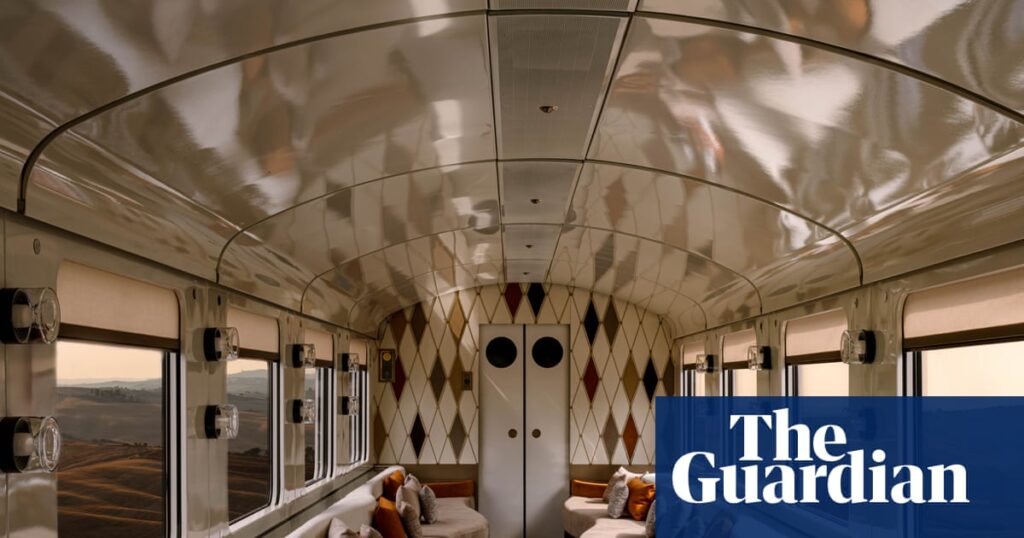‘If anyone mysteriously vanishes, I can be Poirot,” said the passenger from India, twirling his moustache. It felt as though the spirit of Agatha Christie’s most famous character – best known for solving the Murder on the Orient Express – was lingering in the breeze at Palermo’s sublime botanical garden, which had been transformed into a makeshift waiting room for the 40 or so travellers about to board an Italian replica of the fabled train.
Sipping espresso and sampling cannoli, the classic Sicilian pastry, the curiosity and suspicion for which Poirot is famous was palpable as the passengers subtly sized each other up. But the only mystery waiting to be unravelled over the next couple of days was whether their Rome-bound journey on La Dolce Vita Orient Express would live up to their dreamy expectations.
The sleeper rolled into service in April with the aim of reviving the glamour of the original train, as well as the romanticised notion of Italy’s dolce vita, or “sweet life”, not to mention tapping into the resurgence in demand for slow luxury travel.
Comprising refurbished carriages formerly in service on Italy’s railway in the 1960s, the train has spent the last few months taking passengers on various journeys: through Tuscany’s wine region, to Venice and along the Ligurian coast – all of them sold out.
Now the Dolce Vita has ventured south, and the Guardian was invited to experience its debut voyage from Palermo, Sicily, to the Italian capital.
The original Orient Express made its initial journey in 1883, and crossed much of Europe on long-distance itineraries stretching from Paris to Istanbul, before reaching the end of the line in 2009, the victim of both high-speed rail and low-cost flights.
But various offspring kept its legacy alive, with passengers still hungry for high-end nostalgic escapades far from the chaos of airports and overcrowded tourist hotspots.
“The ultra-high-end market is constantly growing and demand for rail experiences is developing in a significant way,” said Dario Minutella, a luxury and fashion sector analyst at the management consultancy firm Kearney. “But it’s not just the preserve of millionaires or billionaires. There are many people with the time and resources seeking an experience, and Italy, with its long coastline and beautiful landscapes beyond the big cities, provides the perfect package.”
At Palermo station, we were greeted by Stefano Sgambellone, the Dolce Vita’s train manager, and his team of impeccably dressed staff.
“In 1883, the Orient Express became the first way to travel slowly, in luxury,” said Sgambellone, who for years worked for Venice Simplon-Orient-Express (VSOE), a luxury rail service with a range of European routes. “Today, slow travel is even more popular than it was then.”
While the focus of VSOE is primarily the onboard experience, the Dolce Vita itinerary also includes off-board jaunts and experiences across its 10 Italy-only itineraries, such as learning to cook a local dish, exploring off-the-beaten-track medieval towns and dining in a private Venetian home.
“People are choosing the Dolce Vita not only for the train itself, which is beautiful, but because it’s the best way to discover Italy,” said Sgambellone.
The train’s whistle blew at 10.30am, and we departed Palermo. It then glided along Sicily’s sparkling northern coastline, passing the town of Cefalù and the city of Messina, offering distant views of Salina, one of the Aeolian islands, along the way.
Lunch has been curated by Heinz Beck, owner of the three-Michelin-starred La Pergola restaurant in Rome. In the afternoon, the train stopped in the Sicilian hilltop town of Taormina, where passengers had the opportunity to explore its ancient Greek theatre.
after newsletter promotion
The Dolce Vita initiative, with plans for a fleet of six trains, is a collaboration between Orient Express, the brand part-owned by the French hospitality group Accor; Arsenale, an Italian luxury hospitality company; and the heritage arm of Italy’s state railway, Ferrovie dello Stato Italiane.
Itineraries are between one and three nights onboard, and needless to say, they do not come cheap,starting at €3,060 per person for a two-day/one-night trip into the heart of Tuscany’s wine region, to more than double that for the three-day/two-night trips.
The luxury train is not the only service that has benefited from FS Italiane’s project to revive abandoned rail tracks. A network of historic routes has opened up under its Timeless Tracks initiative, offering a cheap way to explore Italy’s less visited areas, such as the highlands and hidden hamlets of Abruzzo or the mountains of Friuli-Venezia Giulia, while promoting sustainable tourism. Tickets for these shorter trips start at just €5. There has also been a renewed focus on sleeper train services.
The passengers on this trip had come from all over the world. There was the family from India seeking a once-in-a-lifetime experience; another, from Scotland, celebrating a milestone birthday. There was the US author, the Italian ambassador and the Parisian couple who are seasoned long-distance train travellers.
It was also the first time that Britt Moran and Emiliano Salci, the architects from the Milan-based Dimorestudio who designed Dolce’s 1960s-inspired cabins, restaurant and bar, had travelled on the train.
“Obviously we had seen it before,” said Moran, “but in terms of the whole experience: wow, this is so nice!”
After a night onboard in Sicily, the carriages were loaded on to a privately chartered ferry for the 30-minute crossing to the mainland. From there, the train headed up the coast of Calabria and towards Maratea, where it made another afternoon stop, before departing for Rome in the evening.
When the Dolce Vita arrived at Ostiense station the next morning, all the passengers appeared to be satisfied. While they boarded the train as strangers, running the risk of animosity in such a confined space for two days, they disembarked as friends.
The trip was provided by La Dolce Vita Orient Express; the three-day/two-night From Sicily to Rome trip starts at €11,280 per person (From Rome to Sicily starts at €9,440)
